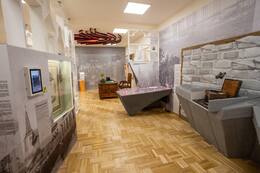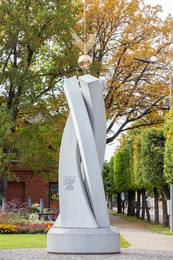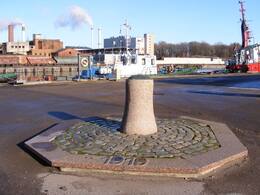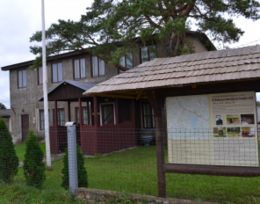Latvijos laikinoji nacionalinė taryba (LPNP)
I WW1, I Nepriklausomybės karai
Latvijos laikinoji tautinė taryba (LPNP) – Latvijos politinė atstovaujamoji organizacija, įkurta 1917 m. lapkritį Valkoje (angl. Latvian Provisional National Council, German Lettlands Vorläufiger Nationaler Rat, Russian Латышский временный национальный совет).
LPNP delegavo Latvijos politinės partijos ir visuomeninės organizacijos. Ši organizacija tarptautiniu mastu gynė Latvijos tautos apsisprendimo teisę iki Latvijos Liaudies Tarybos posėdžio (1918 m. lapkričio 17 d.). LPNP tikslas buvo ginti Latvijos tautos, susivienijusios vienoje etnografinėje teritorijoje, atstovauti jos interesams kitoje taikos konferencijoje ir užtikrinti Steigiamojo susirinkimo sušaukimą. Jos uždaviniai buvo sušaukti Latvijos Steigiamąjį susirinkimą, kuris spręstų dėl Latvijos vidaus santvarkos ir „išorės santykių“; užtikrinti išsklaidytų tautų grįžimą į tėvynę; protestuoti prieš bet kokį Latvijos prijungimą prie Vokietijos; reikalauti Latgalos atskyrimo nuo Vitebsko gubernijos ir prijungimo prie Latvijos.
1917 m. lapkričio 17 d. (vietos laiku 30.11 val.) Valkoje LPNP įkūrė 29 delegatai iš 13 pilietinių partijų ir organizacijų. Po jos įsteigimo prasidėjo pirmoji LPNP sesija, kuri tęsėsi iki 1917 m. lapkričio 19 d. (vietos laiku 02.12 val.). Buvo priimta keletas rezoliucijų ir deklaracijų, iš kurių svarbiausia buvo deklaracija „Užsienio šalims ir tautoms“: „Latvija, kuriai priklauso Vidzemė, Kuržemė ir Latgala, yra autonominis valstybinis darinys, kurio statusą santykiuose su išoriniu pasauliu ir vidaus sistema nustatys jos Steigiamasis susirinkimas ir liaudies plebiscitas.“
19.11. (j.st.02.12).1917 m. išrinktas LPNP valdyba. Pirmininku išrinktas advokatas Voldemaras Zamuelas, pirmininku – advokatas Kārlis Pauļuks, antrasis leitenantas Jānis Rubulis ir karys Jānis Palcmanis; sekretoriumi notaras Kristaps Bahmanis, sekretoriai – rašytojai Kārlis Skalbis ir Jānis Akurateras; iždininkas – kooperatorius Vili Siliņš, o komercijos inžinierius Eduards Laursons – iždininko narys.
1917 m. lapkričio 25 d. (išleista 1918 m. lapkričio 8 d.) LPNP išleido kreipimąsi „Visiems latviams!“, kuris 30 tūkstančių egzempliorių tiražu buvo išplatintas ne vokiečių okupuotoje Latvijos dalyje ir Latvijos pabėgėlių centruose Rusijoje. Kreipimesi LPNP informavo apie savo įkūrimą ir paragino latvius pasinaudoti savo apsisprendimo teise. 1917 m. gruodžio 19 d. (išleista 1918 m. sausio 1 d.) Bolševikų Iskolatas uždraudė LPNP veiklą, o jos valdyba toliau nelegaliai veikė. Organizacijos Užsienio reikalų skyrius veikė Petrograde, kur 1918 m. sausio 28–30 d. taip pat vyko 2-oji LPNP sesija, kurios priimtoje deklaracijoje pirmą kartą buvo iškeltas tikslas, kad „Latvija turi būti nepriklausoma demokratinė respublika, vienijanti Kuršą, Vidžemę ir Latgalą“.
1918 m. spalį prasidėjo diskusijos tarp LPNP ir vokiečių okupuotoje Rygoje įkurto Demokratinio bloko dėl Latvijos ikiparlamento įsteigimo. Paskutinis LPNP valdybos posėdis įvyko 1918 m. lapkričio 17 d., jame buvo nuspręsta netrukdyti įsteigti Latvijos Liaudies Tarybą, kuri lapkričio 18 d. turėjo paskelbti Latvijos Respubliką. Taigi LPNP nustojo egzistavusi.
Daugiau informacijos šaltinių
Jānis Tomaševskis. Nepriklausomybės šnabždesiai: Latvijos laikinosios nacionalinės tarybos istorija, Ryga, Jumava, 2017.; Jānis Tomaševskis. Latvijos laikinoji nacionalinė taryba. Nacionalinė enciklopedija. https://enciklopedija.lv/skirklis/27579-Latvie%C5%A1u-pagaidu-nacion%C4%81l%C4%81-padome
Susijusi laiko juosta
Susijusios vietos
Ekspozicija „Valka – Latvijos Nepriklausomybės lopšys“
Valkos kraštotyros muziejus yra Valkoje, dešinėje Rygos gatvės pusėje, istoriniame Vidžemės parapijos mokyklos mokytojų seminarijos pastate. Nuo 1853 iki 1890 m. pastate veikė Vidžemės parapijos mokyklos mokytojų seminarija. Iki 1881 m. jai vadovavo Janis Cimze, mokytojas ir Latvijos chorinės kultūros pradininkas. Uždarius mokyklos mokytojų seminariją, pastatas 80 metų tenkino įvairius švietimo, kultūros ir buities poreikius. Nuo 1970 m. pastate įsikūręs Valkos kraštotyros muziejus. Nuolatinė muziejaus ekspozicija „Valka – Latvijos nepriklausomybės lopšys“ pasakoja apie socialinius ir politinius įvykius Valkoje nuo 1914 iki 1920 m., kai Latvija tapo nepriklausoma valstybe. Ekspozicija atspindi pasirengimą Latvijos valstybės įkūrimui ir Šiaurės Latvijos brigados formavimui Valkoje. Parodoje, perteikiant keturias prasmes – Kelį, Tarybą, Būstinę ir Namus, daugiausia dėmesio skiriama temoms, susijusioms su Valkos miestu, pabėgėliais, Latvijos ūkininkų sąjungos įkūrimu (1917 m.),
Latvijos laikinoji nacionalinė taryba (1917 m.), Latvijos laikinasis nacionalinis teatras (1918 m.), Laikinoji Sovietų Latvijos vyriausybė, žinoma kaip Iskolat, Šiaurės Latvijos brigada (1919 m.) ir generolas Pēteris Radziņš. Be tradicinių kolekcijų eksponavimo būdų, parodoje naudojami interaktyvūs multimedijos sprendimai.
Paminklas „Atidavimas Latvijos Laikinajai Nacionalinei Tarybai“
Paminklas „Atidavimas Latvijos laikinajai nacionalinei tarybai“ yra Valkoje, Rygos ir Rainės gatvių sankryžoje (adresas Rainės gatvė 9A).
Paminklas buvo atidengtas 2017 m. gruodžio 2 d., kaip Latvijos šimtmečio programos dalis, pagerbiant 1917 m. vykusį Latvijos Laikinosios Nacionalinės Tarybos posėdį.
Ansamblio idėjos autorė – skulptorė Arta Dumpė, akmenkalys – Ivaras Feldbergas, architektūrinį planavimą atliko SIA „Architektūros biuras Vecumnieks & Bērziņi“.
Paminklo pagrindą sudaro didelis girnapusė – tarsi gyvenimo, laiko ir įvykių ratas. Jo šonuose iškalti LPNP valdybos narių vardai ir pavardės. Iš girnapusės, tarsi likimo takai, į dangų kyla trys regionai – Vidžemė, Kuržemė ir Latgala su savo istoriniais herbais. Kompoziciją užbaigia Betliejaus žvaigždė, kuri virsta naujosios Latvijos valstybės saule. Latvių poetas, prozininkas ir politikas Kārlis Skalbe /1879–1945/ rašė: „Latvija irgi turėjo savo Betliejų, mažoji vargšė Valka...“.
Latvijos laikinosios nacionalinės tarybos paminklas yra savotiška skolos grąžinimo forma žmonėms, kurie 1917 m. Valkoje, rizikuodami savo gyvybėmis, vedami idealų, praktiškai beviltiškoje situacijoje padėjo Latvijos valstybės pamatus.
Tuo metu Valka buvo miestas su didžiausia latvių populiacija teritorijoje, kurios dar neokupavo Vokietija. Po Rygos žlugimo ji tapo Latvijos socialinio, politinio ir kultūrinio gyvenimo centru. Čia rinkdavosi tie, kuriuos vienijo noras įgyvendinti latvių tautos apsisprendimo teisę. Nuo 1917 m. lapkričio 29 d. iki gruodžio 2 d. (pagal naująjį stilių) Valkos miesto rotušėje (dabar pastatas Kesk gatvėje Nr. 11 Valgoje) vyko pirmoji Latvijos laikinosios nacionalinės tarybos sesija, kurioje dalyvavo beveik visų įtakingiausių Latvijos visuomeninių organizacijų ir politinių partijų atstovai. Pirmą kartą jie oficialiai paskelbė savo veiklos tikslą – nepriklausomos nacionalinės valstybės sukūrimą – ir priėmė deklaraciją dėl vieningos ir autonominės Latvijos sukūrimo Latvijos Vidžemės, Kuržemės ir Latgalos rajonuose.
Laivo „Saratov“ prieplauka Liepojoje
„Saratov“ prieplauka yra Liepojoje, Senojoje uoste, 59, netoli laivų prieplaukos.
Pastatytas 1888 m. Kopenhagoje laivų statyklos „Buvmeistar & Wain“ pavadinimu „Leopold II“, 1911 m. jį įsigijo akcinė bendrovė „Russian North-West Shipping“ ir pervadino į „Saratov“, o laivo kapitonu tapo latvis Aleksandras Remessas.
1915 m. gegužę, kai Liepoją okupavo vokiečių kariuomenė, laivas „Saratovas“ uoste buvo apgadintas.
1919 m. sausio 10 d. garlaivį „Saratov“ perėmė Latvijos laikinoji vyriausybė. Nuo 1919 m. balandžio iki liepos mėn., po „balandžio 16 d. perversmo“, K. Ulmanio vadovaujama laikinoji vyriausybė buvo „Saratov“ laive ir buvo priversta slėptis sąjungininkų laivyno globoje.
1919 m. liepos 8 d., laikinajai K. Ulmanio vyriausybei perdavus Rygą, garlaiviai buvo naudojami susisiekimui tarp Rygos, Ventspilio ir Liepojos.
Pagal 1920 m. rugpjūčio 11 d. Latvijos ir Sovietų Rusijos taikos sutarties sąlygas garlaivis „Saratovas“ turėjo būti grąžintas Sovietų pusei. 1923 m. sausio 2 d. garlaivis buvo perduotas Sovietų Rusijos atstovui. 1923 m. sausio 15 d. garlaivis „Saratovas“ sudužo prie Akmenrago krantų.
1936 m. Latvijos jūrų departamentas pardavė nuolaužas įmonei, kuri jas sutvarkė ir perdavė Liepojos audinių fabrikui.
Rubenio bataliono muziejus
Rubenio bataliono muziejus yra Ugalėje. Jis skirtas R. Rubenio batalionui, kuris 1944 m. tarnavo ir kovojo Kuržemėje vadovaujant generolui J. Kureliui, kurelių veiklai ir nacionaliniam pasipriešinimo judėjimui. Muziejuje yra ekspozicija apie Latvijos Centrinės Tarybos (LKT) ir jos Ventspilio grupės veiklą, taip pat LKT memorandumas su 188 parašais ir signatarų nuotraukomis, įtrauktas į UNESCO programos „Pasaulio atmintis“ Latvijos nacionalinį registrą. LKT buvo bendras Latvijos aukščiausios politinės vadovybės ir pogrindinės vyriausybės, veikusios Latvijos okupacijos metu nuo 1943 iki 1994 m., centras. Jis buvo įkurtas siekiant koordinuoti įvairių Latvijos pasipriešinimo judėjimų veiklą, siekiant atkurti Latvijos nacionalinę nepriklausomybę. Muziejus taip pat siūlo kelionę į bataliono istorijai reikšmingas vietas (gyvenvietę su rekonstruotu bunkeriu Usmos valsčiuje, mūšio laukus Rendos ir Zlėkų valsčiuose ir kt.).
Susijusi istorija
1917 m. kovas – svarbus mėnuo Valmieros ir Latvijos istorijoje
1917 m. kovo mėn., likus daugiau nei metams iki Latvijos valstybės paskelbimo, Valmieroje buvo įkurta Vidžemės laikinoji žemės taryba, kuri priėmė rezoliuciją dėl Latvijos autonomijos ir apsisprendimo teisių. Tarybos įkūrimo dieną posėdžių vietoje pirmą kartą buvo iškelta raudonai baltai raudona vėliava.
Artūro Ozolo prisiminimai apie laivą „Saratov“
Artūras Ozolas baigė Rygos politechnikos institutą ir tarnavo Rusijos Juodosios jūros laivyne karininku (mičmanu) ir inžinieriumi karo laive „Panteleimon“. Latvijos išsivadavimo kovos metu jis įstojo į Studentų kuopą. Liepojoje jis pradėjo eksploatuoti laivą „Saratov“. Artūro Ozolo atsiminimai apie laivą „Saratov“ buvo publikuoti Daugagavos Vanagi mėnesiniame leidinyje.
Iš Ádolfo Erso knygos „Vidzemė kovoje už laisvę“ apie pabėgėlių kelionę Valkoje
Nuo pabėgėlių laikų Valkai buvo skiriamas svarbesnis vaidmuo nei kitiems Vidžemės miestams, nes čia buvo leidžiamas politiškai aktyvus laikraštis „Līdums“, kuriame buvo kaldinami Latvijos dvasiniai ir politiniai ginklai, taip pat todėl, kad tai buvo kryžkelė, kurioje susitiko keliai iš trijų Latvijos pusių: iš Rygos, Alūksnės, Mozekilės, taip pat iš Estijos ir Rusijos. Ji turėjo ryšių su pabėgėliais iš visų pusių – Tartu, Pliskos, Maskvos ir Sankt Peterburgo. Čia buvo didelis pabėgėlių centras.
Kyšulys ir laivas „Saratovas“
Galima manyti, kad Liepoja trumpą laiką buvo Latvijos sostinė, nes Laisvės kovų metu Laikinoji vyriausybė buvo dislokuota laive „Saratov“ būtent šiame mieste. „Saratov“ po Rygos išlaisvinimo Laikinąją vyriausybę nugabeno į ją, tačiau daugelis žmonių nežino, kad tokio svarbaus mums laivo istorija baigėsi jūroje, Akmenrage.
Akmeņrago švyturys ir seklumėlė – viena didžiausių laivų kapinių Baltijos jūroje
Būtent Akmensrago švyturio rajone 1923 m. sausio 13 d. tragiškai užplaukė ir sudužo garlaivis „Saratov“ , kuriuo, įkūrus nepriklausomą Latvijos valstybę, prieglobstį rado K. Ulmanio vadovaujama laikinoji vyriausybė.









